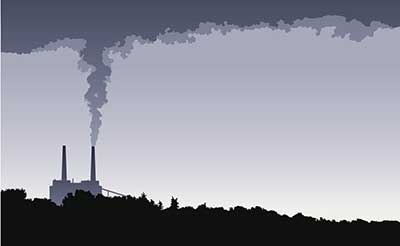Date: 03/11/2022
Relevance: GS-3: Environmental Pollution & Degradation.
Key Phrases: State Pollution Control Boards, Pollution Control Committees, Water (Prevention And Control Of Pollution) Act, 1974, Air (Prevention And Control Of Pollution) Act, Of 1981, National Clean Air Programme
Why in News?
- In the fight against air pollution in the Indo-Gangetic Plain, the State Pollution Control Boards (SPCBs) and the Pollution Control Committees (PCCs) in the Union Territories are the key players.
- However, as the environmental indicators such as air quality and water quality worsen in many parts of the country, the Boards are evidently failing to effectively discharge their statutory mandate.
Key Highlights about the SPCBs and the PCCs:
- The SPCBs were initially constituted under the Water (Prevention and Control of Pollution) Act, 1974.
- Under the Air (Prevention and Control of Pollution) Act, of 1981, the SPCB mandate was expanded to include air quality management.
- Their primary role is to regulate emissions from point sources such as industries and power plants that contribute substantially to ambient air pollution in urban and rural areas.
Enhanced mandate of the SPCBs and the PCCs:
- Recently, they have been tasked with guiding cities in meeting targets under the National Clean Air Programme and spending Finance Commission grants for air quality improvements.
- Subsequently, several new environmental regulations were added to their roles and functions.
Key institutional constraints with the workings of boards and their implications on air quality governance in India:
- Conflict of interest in the board composition:
- Over 50% of the Board members across the 10 SPCBs and PCC which have been studied, represent potential polluters from local authorities, industries, and public sector corporations.
- They are subject to the SPCB’s regulatory measures, and their overwhelming presence raises fundamental questions about the conflicts of interest.
- Not meeting the statutory requirement:
- Most Boards do not meet the statutory requirement of having at least two Board members who have knowledge of, and experience in, air quality management.
- At the same time, scientists, medical practitioners, and academics constitute only 7% of the Board members.
- Thus, the enhanced mandate has not been matched with increased capacity and capability in the Boards.
- The lack of expertise and skewed representation of stakeholders on
the Boards can only be a hindrance to effective policymaking.
- Given the scale and causes of air pollution in India, multi-disciplinary expertise is needed to tackle it and there must also be an explicit focus on health while designing air pollution policy.
- Lack of a stable and full-time tenure:
- The SPCB leadership i.e., the chairperson and the member secretary do not enjoy a long, stable, and full-time tenure.
- In many States, persons in these two posts hold an additional charge in other government departments.
- Moreover, several chairpersons and member secretaries have held their posts for less than a year.
- For example, the shortest tenure for a chairperson has been 18 days (Chhattisgarh), and 15 days for a member secretary (Haryana and Uttar Pradesh).
- With the focus of the leadership of SPCB spread thin across multiple roles and their tenures being short, often they do not even have the time to understand their mandate fully before they are moved out.
- In such a scenario, long-term policy planning, strategic interventions and effective execution aimed at reducing air pollution substantially are extremely difficult.
- SPCBs running understaffed:
- The SPCBs are critically under-staffed where at least 40% of all sanctioned posts are vacant across nine SPCBs/PCCs.
- Vacancy levels in technical positions are as high as 84% in Jharkhand and over 75% in Bihar and Haryana.
- An inadequate staff strength forces the Boards to recast their
priorities among their various functions.
- This has significant implications on pollution regulation as vital functions such as monitoring industrial compliance, initiating enforcement actions in case of violations, and standard setting are often not prioritised.
- Less staff strength also means weaker regulatory scrutiny and poor impact assessment. For example, given their workload, engineers in Bihar, Jharkhand, Punjab, and Uttar Pradesh have less than a day to inspect, evaluate and decide on each consent application.
Incentives by various stakeholders to counter Air pollution:
- WHO’s 4 Pillar Strategy:
- WHO adopted a resolution (2015) to address the adverse health effects of air pollution.
- This 4-pillar strategy calls for an enhanced global response to the
adverse health effects of air pollution. Those four pillars are:
- Expanding the knowledge base
- Monitoring and reporting
- Global leadership and coordination
- Institutional capacity strengthening
Government of India and state government's initiatives:
- Constitution of Commission for Air Quality Management (CAQM) in National Capital Region (NCR) and adjoining areas.
- The introduction of BS-VI vehicles and push for electric vehicles (EVs).
- Subsidy to farmers for buying Turbo Happy Seeder (THS) which is a machine mounted on a tractor that cuts and uproots the stubble, in order to reduce stubble burning.
- Implementation of the Graded Response Action Plan (GRAP)
- It is a set of curbs triggered in phases as the air quality deteriorates, which is typical of the October-November period.
- Development of the National Air Quality Index (AQI) for public information under the aegis of the Central Pollution Control Board (CPCB).
- Construction of the Eastern and Western Peripheral Expressways to reduce vehicular pollution.
Conclusion:
- The institutional picture gets worse when one considers the massive mandate of the Boards on environmental issues beyond air quality.
- Without essential capacity, capability, expertise, and vision in our frontline regulators, sustained and substantial gains in air quality are virtually impossible.
- In short, there is no future with clean air in which the SPCBs do not perform at the highest level possible.
Source: The Hindu
Mains Question:
Q. Discuss the key institutional constraints with the workings of pollution control boards and their implications on air quality governance in India. (150 words).






















